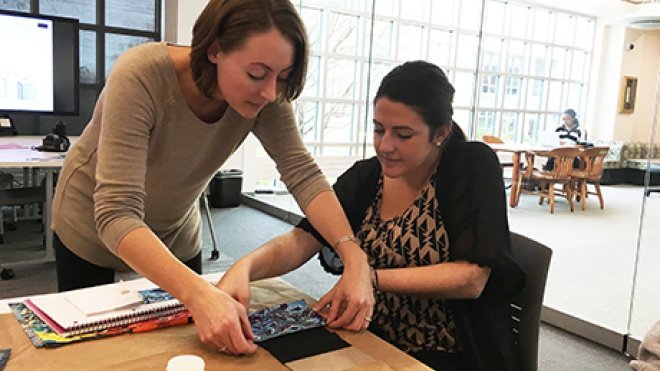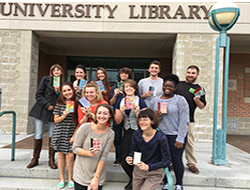Under Cover: The Art of the Book with RWU Librarians Lindsey Gumb and Heidi Benedict
Creative Writing students go behind the pages to learn the basics of bookbinding

BRISTOL, R.I. – In the age of the e-book and discount paperbacks, it’s easy to forget that, until the 20th century, books were exclusively bound by hand – a practice that can be traced back to the first century B.C. But the ancient art form was alive and well at the Roger Williams University Library recently, when university librarians Lindsey Gumb and Heidi Benedict instructed a workshop in book arts for creative writing students.
The Mary Tefft White Cultural Center was a conflation of modern technology and antique bookbinding tools when students from Associate Professor of Creative Writing Renee Soto’s “Writers Reading Poetry” class sat down to make their very own books. It’s safe to say that these budding authors know their way around a book – though they typically find themselves filling the pages rather than stitching them together.
Soto was inspired to incorporate lessons on bookmaking – including paper marbling, which involves tapping paint onto a  viscous solution to create striking patterns that are then transferred onto paper coated with aluminum sulfate – when a student in her senior seminar decided to make her own books as part of her creative writing thesis.
viscous solution to create striking patterns that are then transferred onto paper coated with aluminum sulfate – when a student in her senior seminar decided to make her own books as part of her creative writing thesis.
“It’s something that my students are really becoming curious about and think more about,” Soto says. “What constitutes a book? What is the nature and spirit of a book? What is the effort in terms of making the book?”
She took a course on paper marbling – a common technique for designing paper to cover handmade books – to teach her students and recruited the library staff to instruct them on the mechanics of constructing a book. Librarians are not often looked at as faculty, Soto says, but they are professors in their own right and should be called upon as a teaching resource.
During the two-hour seminar, the students were walked through the process of bookmaking – from creating signatures to stitch together a text block to attaching the binding and dressing up the cover boards with paper they had marbled in the visual arts studio just a day earlier.
“Ironically, I’m the technology librarian here, but I truly enjoy working with physical books,” says Gumb, who was first introduced to book arts in library school and trained at the North Bennet St. School. “I was trained to book bind from scratch. So I’m really drawn to the definition of book arts being the book as an art object while also observing the traditional practices of the art of the book.”
By the end of the class, each of the students walked away with their original book, as well as a new appreciation for the process behind the books they’re so passionate about reading – and writing – excited for the opportunity to further explore this new (albeit ancient) artform.